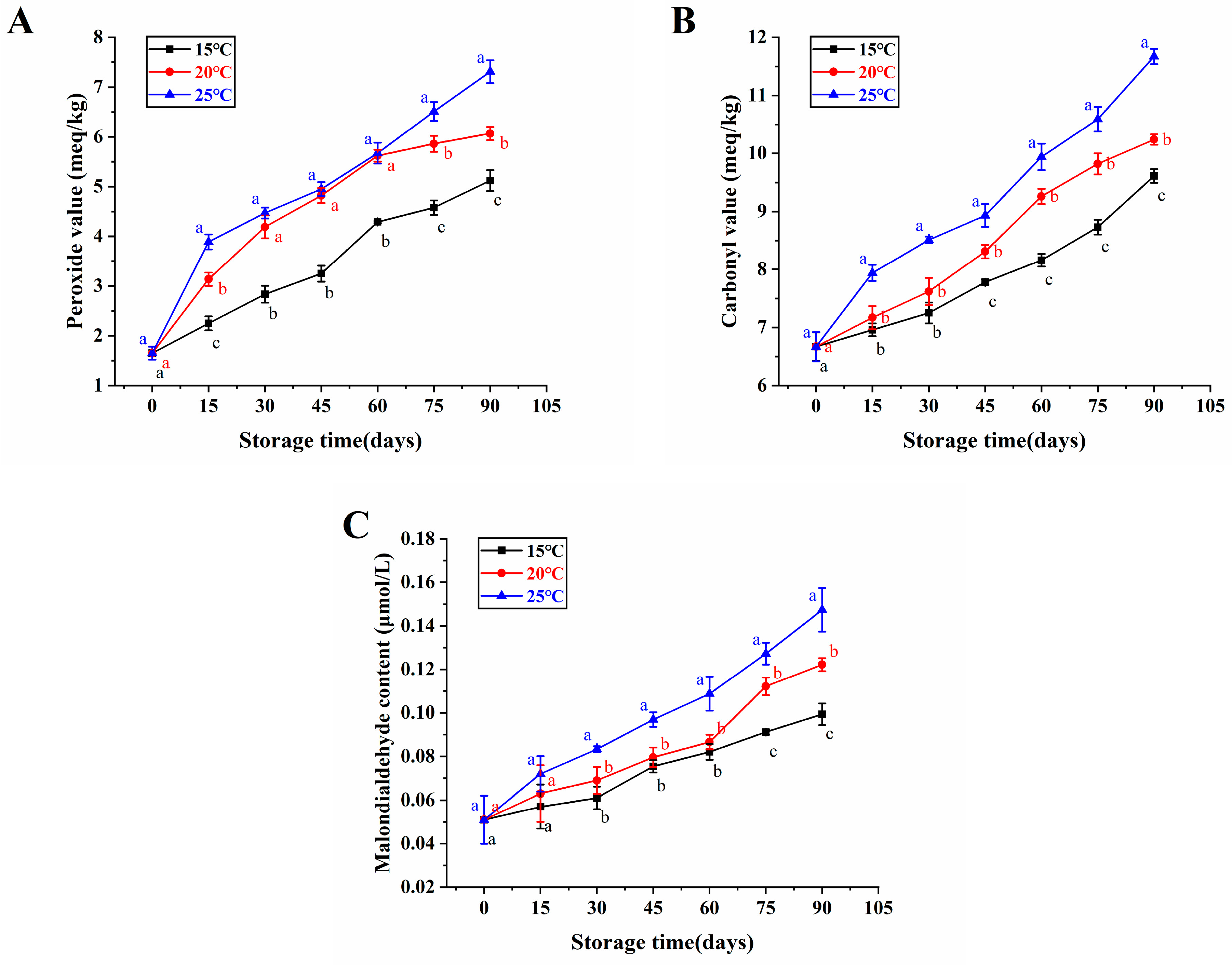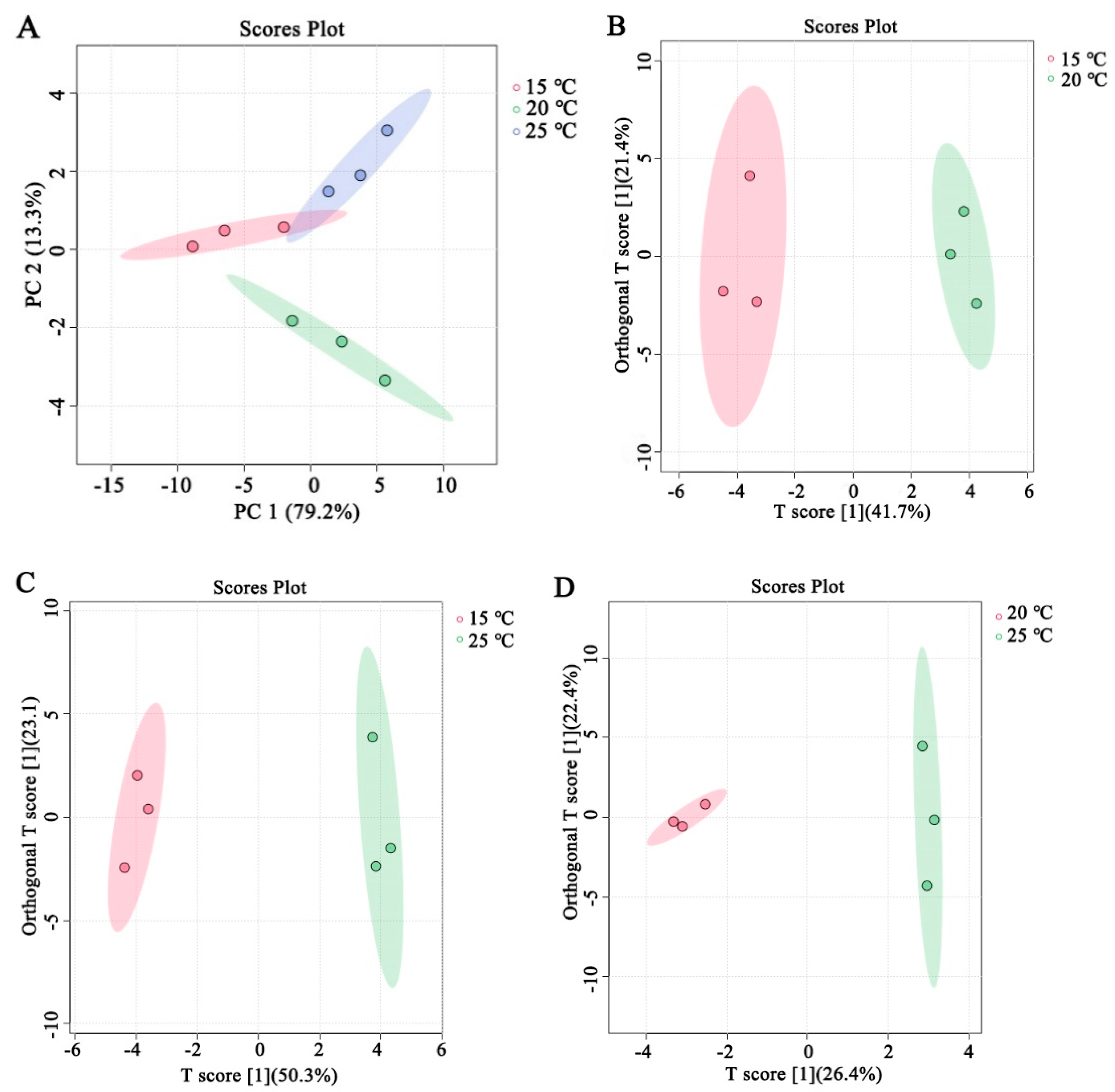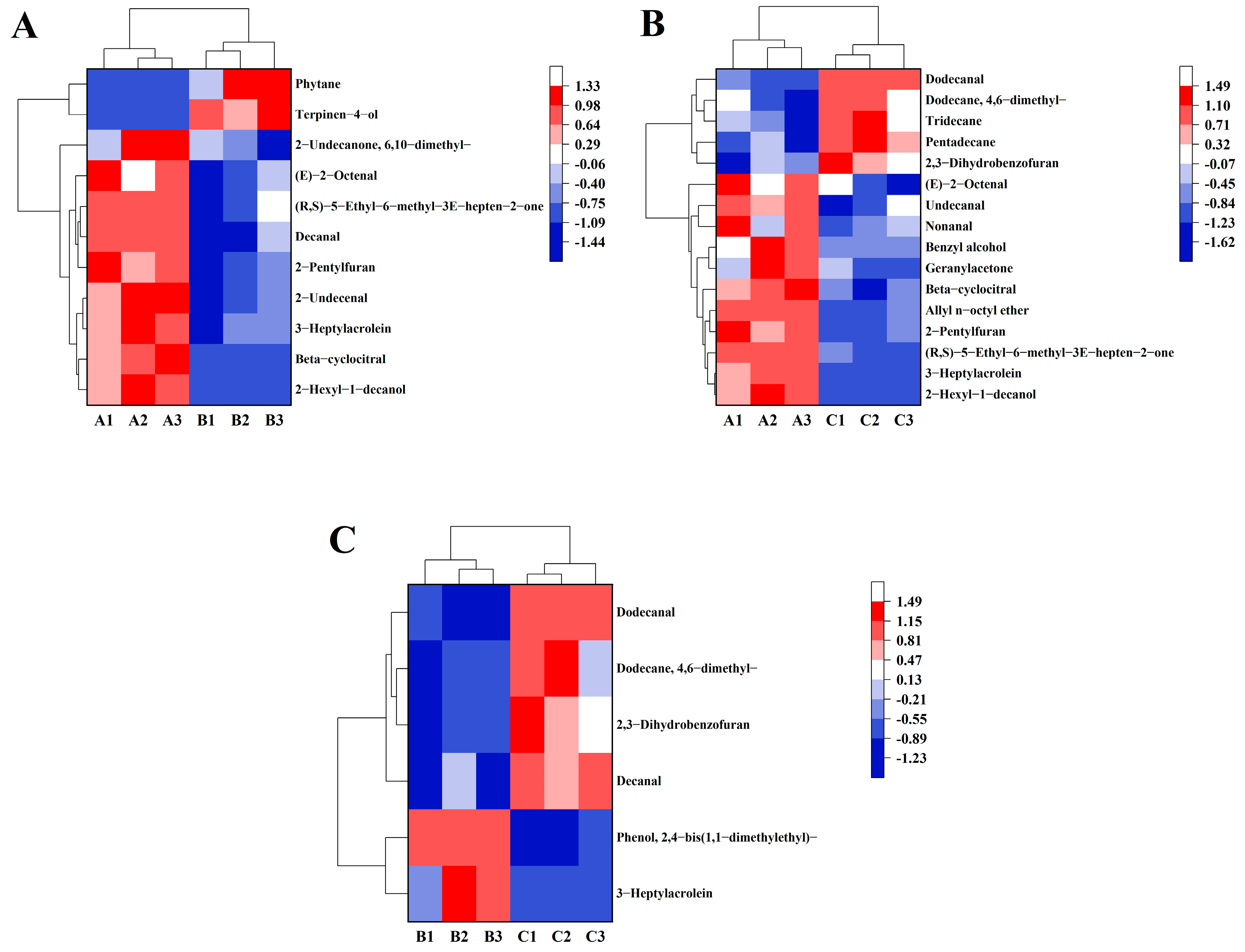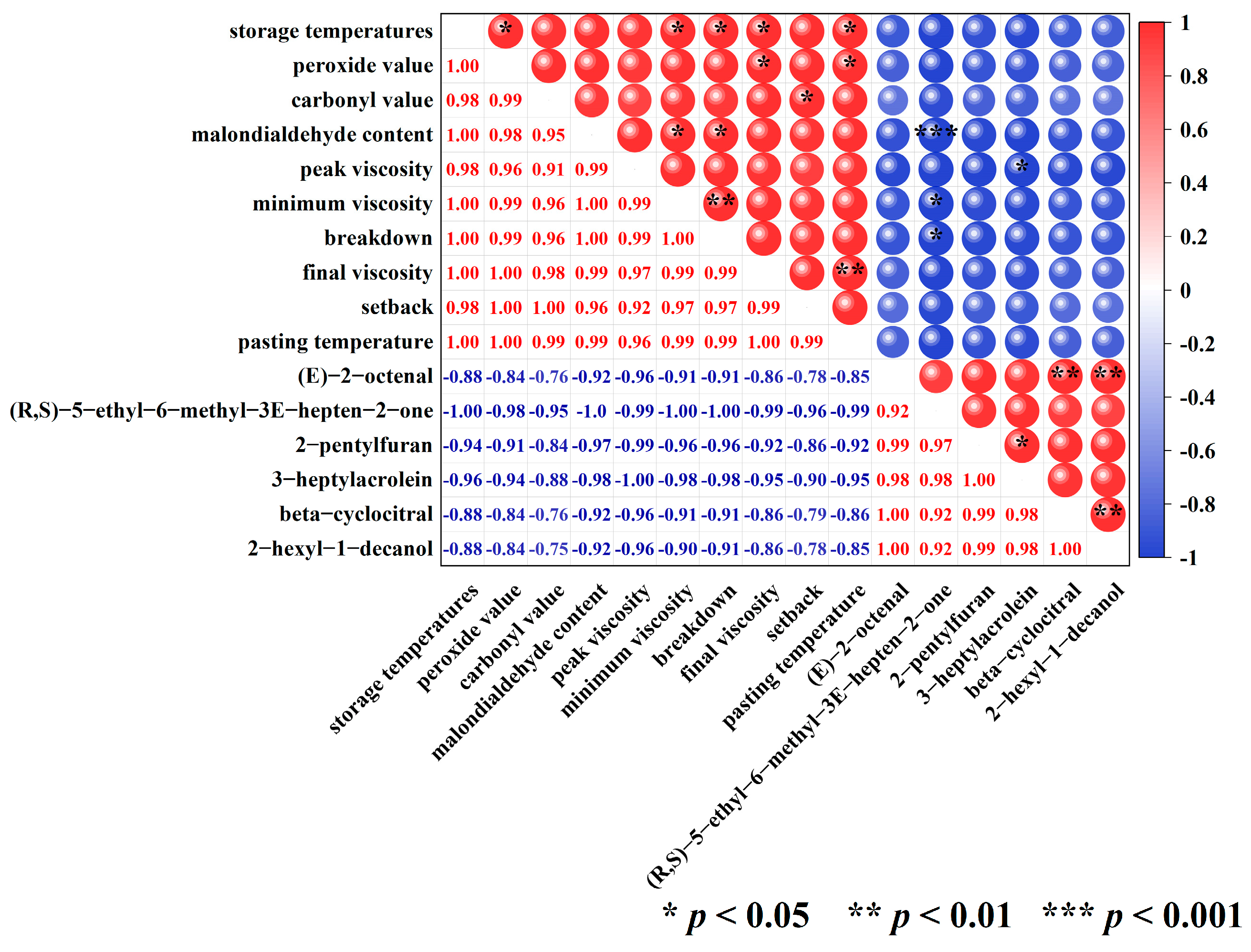Oxidative Stability and Pasting Properties of High-Moisture Japonica Brown Rice following Different Storage Temperatures and Its Cooked Brown Rice Flavor
Abstract
:1. Introduction
2. Materials and Methods
2.1. Materials
2.2. Sample Storage
2.3. Extraction of Japonica Brown Rice Oil
2.4. Peroxide Value, Carbonyl Value, and Malondialdehyde Content
2.5. Pasting Properties
2.6. Dissection of Flavor Volatiles
2.6.1. Japonica Brown Rice Cooking
2.6.2. HS-SPME/GC-MS Analytical Procedures
2.7. Statistics
3. Results and Discussion
3.1. Oxidative Stability
3.2. Pasting Properties
3.3. Flavor Volatiles
3.3.1. Detection and Flavor Characterization of Flavor Volatiles in Cooked Japonica Brown Rice with High Moisture Content
3.3.2. PCA and OPLS-DA Analysis
3.3.3. Identification of Key Flavor Volatiles in Cooked Japonica Brown Rice with High Moisture Content
3.3.4. Dissection of Key Flavor Volatiles in Cooked Japonica Brown Rice with High Moisture Content
3.4. Correlation Analysis of Storage Temperatures, Oxidative Parameters, Pasting Properties, and Key Flavor Volatiles
4. Conclusions
Supplementary Materials
Author Contributions
Funding
Institutional Review Board Statement
Informed Consent Statement
Data Availability Statement
Conflicts of Interest
References
- Zhang, D.; Duan, X.L.; Shang, B.; Hong, Y.; Sun, H. Analysis of lipidomics profile of rice and changes during storage by UPLC-Q-extractive orbitrap mass spectrometry. Food Res. Int. 2021, 142, 110214. [Google Scholar] [CrossRef] [PubMed]
- Maiti, S.; Banik, A. Strategies to fortify the nutritional values of polished rice by implanting selective traits from brown rice: A nutrigenomics-based approach. Food Res. Int. 2023, 173, 113271. [Google Scholar] [CrossRef] [PubMed]
- Wu, X.X.; Guo, T.Y.; Luo, F.J.; Lin, Q.L. Brown rice: A missing nutrient-rich health food. Food Sci. Hum. Wellness 2023, 12, 1458–1470. [Google Scholar] [CrossRef]
- Wang, B.H.; Luo, J.J.; Zhang, Q.L.; Cao, X.; Zhang, Y.J.; Huang, Z.Q.; Hu, H.Y.; Gan, T. Storage of brown rice and its physicochemical properties under high temperature and humidity negative air ions environment. J. Cereal Sci. 2023, 112, 103723. [Google Scholar] [CrossRef]
- Saleh, A.S.M.; Wang, P.; Wang, N.; Yang, L.; Xiao, Z.G. Brown Rice Versus White Rice: Nutritional Quality, Potential Health Benefits, Development of Food Products, and Preservation Technologies. Compr. Rev. Food Sci. Food Saf. 2019, 18, 1070–1096. [Google Scholar] [CrossRef] [PubMed]
- Luo, X.H.; Li, Y.L.; Yang, D.; Xing, J.L.; Li, K.; Yang, M.; Wang, R.; Wang, L.; Zhang, Y.W.; Chen, Z.X. Effects of electron beam irradiation on storability of brown and milled rice. J. Stored Prod. Res. 2019, 81, 22–30. [Google Scholar] [CrossRef]
- Ziegler, V.; Ferreira, C.D.; Hoffmann, J.F.; Chaves, F.C.; Vanier, N.L.; de Oliveira, M.; Elias, M.C. Cooking quality properties and free and bound phenolics content of brown, black, and red rice grains stored at different temperatures for six months. Food Chem. 2018, 242, 427–434. [Google Scholar] [CrossRef]
- Zhai, Y.H.; Pan, L.H.; Luo, X.H.; Zhang, Y.W.; Wang, R.; Chen, Z.X. Effect of electron beam irradiation on storage, moisture and eating properties of high-moisture rice during storage. J. Cereal Sci. 2022, 103, 103407. [Google Scholar] [CrossRef]
- Qu, L.Y.; Zhao, Y.; Xu, X.D.; Li, Y.F.; Lv, H.X. Untargeted Lipidomics Reveal Quality Changes in High-Moisture Japonica Brown Rice at Different Storage Temperatures. Foods 2023, 12, 4218. [Google Scholar] [CrossRef]
- Lina, G.; Min, Z. Formation and release of cooked rice aroma. J. Cereal Sci. 2022, 107, 103523. [Google Scholar] [CrossRef]
- Kanphassorn, W.; Yoo-Hyun, C.; Sang, L.Y. High temperature-induced alterations of volatile profiles in fragrant brown rice. J. Crop Sci. Biotechnol. 2022, 26, 97–106. [Google Scholar] [CrossRef]
- Ma, R.R.; Tian, Y.Q.; Chen, L.; Jin, Z.Y. Impact of cooling rates on the flavor of cooked rice during storage. Food Biosci. 2020, 35, 100563. [Google Scholar] [CrossRef]
- Zheng, Z.C.; Zhang, C.; Liu, K.W.; Liu, Q.Q. Volatile Organic Compounds, Evaluation Methods and Processing Properties for Cooked Rice Flavor. Rice 2022, 15, 53. [Google Scholar] [CrossRef] [PubMed]
- Elouafy, Y.; El Yadini, A.; El Moudden, H.; Harhar, H.; Alshahrani, M.M.; Al Awadh, A.A.; Goh, K.W.; Ming, L.C.; Bouyahya, A.; Tabyaoui, M. Influence of the Extraction Method on the Quality and Chemical Composition of Walnut (Juglans regia L.) Oil. Molecules 2022, 27, 7681. [Google Scholar] [CrossRef] [PubMed]
- Liu, X.; Li, Y.H.; Liu, Q.; Du, H.J.; Ma, G.X.; Shen, F.; Hu, Q.H. Mechanism of electron beam irradiation on the lipid metabolism of paddy during high temperature storage. J. Cereal Sci. 2023, 111, 103668. [Google Scholar] [CrossRef]
- GB 5009.230-2016; National Standard for Food Safety—Determination of Carbonyl Value in Food. National Health and Family Planning Commission of the People’s Republic of China: Beijing, China, 2016.
- Niu, A.J.; Wu, H.Y.; Ma, F.; Tan, S.; Wang, G.Y.; Qiu, W.F. The antifungal activity of cinnamaldehyde in vapor phase against Aspergillus niger isolated from spoiled paddy. LWT 2022, 159, 113181. [Google Scholar] [CrossRef]
- Qu, C.L.; Xia, Y.Z.; Yang, Q.K.; Li, W.H.; Hu, M.; Lu, P. Novel insights into rice deterioration for nitrogen controlled atmosphere and re-aeration storage based on no-targeted metabolomics. LWT 2023, 178, 114631. [Google Scholar] [CrossRef]
- Zhang, X.X.; Wang, L.; Cheng, M.Y.; Wang, R.; Luo, X.H.; Li, Y.N.; Chen, Z.X. Influence of ultrasonic enzyme treatment on the cooking and eating quality of brown rice. J. Cereal Sci. 2015, 63, 140–146. [Google Scholar] [CrossRef]
- Li, Y.N.; Li, Y.F.; Chen, Z.X.; Bu, L.J.; Shi, F.; Huang, J.R. High-temperature air fluidization improves cooking and eating quality and storage stability of brown rice. Innov. Food. Sci Emerg. Technol. 2021, 67, 102536. [Google Scholar] [CrossRef]
- Zhang, D.; Huang, S.S.; Wang, Q.; Shang, B.; Liu, J.L.; Xing, X.T.; Hong, Y.; Liu, H.; Duan, X.L.; Sun, H. Lipidomics and volatilomics reveal the changes in lipids and their volatile oxidative degradation products of brown rice during accelerated aging. Food Chem. 2023, 421, 136157. [Google Scholar] [CrossRef]
- Huang, R.H.; Huang, K.; Guan, X.; Li, S.; Cao, H.W.; Zhang, Y.; Lao, X.; Bao, Y.Z.; Wang, J. Effect of defatting and extruding treatment on the physicochemical and storage properties of quinoa (Chenopodium quinoa Wild) flour. LWT 2021, 147, 111612. [Google Scholar] [CrossRef]
- Liu, K.L.; Li, Y.; Chen, F.S.; Yong, F. Lipid oxidation of brown rice stored at different temperatures. Int. J. Food Sci. Technol. 2017, 52, 188–195. [Google Scholar] [CrossRef]
- Li, F.; Wu, X.J.; Wu, W. Effects of oxidative modification by malondialdehyde on the in vitro digestion properties of rice bran protein. J. Cereal Sci. 2021, 12, 103158. [Google Scholar] [CrossRef]
- Yan, R.X.; Wang, Z.W.; Zhou, J.; Gao, R.Y.; Liao, S.W.; Yang, H.F.; Wang, F. Gold nanoparticle enriched by Q sepharose spheres for chemical reaction tandem SERS detection of malondialdehyde. Sens. Actuators B Chem. 2019, 281, 123–130. [Google Scholar] [CrossRef]
- Rashid, M.T.; Liu, K.L.; Han, S.M.; Jatoi, M.A.; Sarpong, F. Optimization of Extrusion Treatments, Quality Assessments, and Kinetics Degradation of Enzyme Activities during Storage of Rice Bran. Foods 2023, 12, 1236. [Google Scholar] [CrossRef] [PubMed]
- Zhou, Z.K.; Wang, X.F.; Si, X.; Blanchard, C.; Strappe, P. The ageing mechanism of stored rice: A concept model from the past to the present. J. Stored Prod. Res. 2015, 64, 80–87. [Google Scholar] [CrossRef]
- Zhong, Y.J.; Xiang, X.Y.; Chen, T.T.; Zou, P.; Liu, Y.F.; Ye, J.P.; Luo, S.J.; Wu, J.Y.; Liu, C.M. Accelerated aging of rice by controlled microwave treatment. Food Chem. 2020, 323, 126853. [Google Scholar] [CrossRef] [PubMed]
- Shu, Z.X.; Jia, W.Q.; Zhang, W.; Wang, P.P. Selected quality attributes of paddy rice as affected by storage temperature history. Int. J. Food Prop. 2021, 24, 316–324. [Google Scholar] [CrossRef]
- Shi, S.J.; Pan, K.Q.; Yu, M.; Li, L.; Tang, J.C.; Cheng, B.; Liu, J.; Cao, C.G.; Jiang, Y. Differences in starch multi-layer structure, pasting, and rice eating quality between fresh rice and 7 years stored rice. Curr. Res. Food Sci. 2022, 5, 1379–1385. [Google Scholar] [CrossRef]
- Hu, X.Q.; Lu, L.; Guo, Z.L.; Zhu, Z.W. Volatile compounds, affecting factors and evaluation methods for rice aroma: A review. Trends Food Sci. Technol. 2020, 97, 136–146. [Google Scholar] [CrossRef]
- Sansenya, S.; Hua, Y.L.; Chumanee, S. The Correlation between 2-Acetyl-1-pyrroline Content, Biological Compounds and Molecular Characterization to the Aroma Intensities of Thai Local Rice. J. Oleo Sci. 2018, 67, 893–904. [Google Scholar] [CrossRef] [PubMed]
- Ren, L.Y.; Ma, J.; Lv, Y.; Tong, Q.G.; Guo, H.Y. Characterization of key off-odor compounds in thermal duck egg gels by GC-olfactometry-MS, odor activity values, and aroma recombination. LWT 2021, 143, 111182. [Google Scholar] [CrossRef]
- Yuan, B.; Zhao, C.J.; Yan, M.; Huang, D.C.; McClements, D.J.; Huang, Z.G.; Cao, C.J. Influence of gene regulation on rice quality: Impact of storage temperature and humidity on flavor profile. Food Chem. 2019, 283, 141–147. [Google Scholar] [CrossRef]
- Choi, S.; Seo, H.S.; Lee, K.; Lee, S.; Lee, J. Effect of milling degrees on volatile profiles of raw and cooked black rice (Oryza sativa L. cv. Sintoheugmi). Appl. Biol. Chem. 2018, 61, 91–105. [Google Scholar] [CrossRef]
- Yamashita, K.; Kato, N.; Sakakibara, K.; Seguchi, A.; Kobayashi, A.; Miyagawa, S.; Uchimura, T. Characterization of Cooked Nonglutinous Rice Cultivars Based on Flavor Volatiles and Their Change during Storage. ACS Omega 2023, 8, 14823–14829. [Google Scholar] [CrossRef] [PubMed]
- Yu, C.T.; Zhu, L.; Zhang, H.; Bi, S.L.; Wu, G.C.; Qi, X.G.; Zhang, H.; Wang, L.; Qian, H.F.; Zhou, L. Effect of cooking pressure on phenolic compounds, gamma-aminobutyric acid, antioxidant activity and volatile compounds of brown rice. J. Cereal Sci. 2021, 97, 103127. [Google Scholar] [CrossRef]
- Zhong, Y.J.; He, F.Q.; Wang, M.; Zhang, Y.Q.; Lan, H.J.; Chen, L.; Zeng, Z.C. Effects of stabilization combined with fermentation treatments on the volatile composition and flavor profile of cooked black rice. Food Biosci. 2023, 56, 103377. [Google Scholar] [CrossRef]
- Choi, S.; Seo, H.S.; Lee, K.R.; Lee, S.; Lee, J.; Lee, J. Effect of milling and long- term storage on volatiles of black rice (Oryza sativa L.) determined by headspace solid-phase microextraction with gas chromatography-mass spectrometry. Food Chem. 2019, 276, 572–582. [Google Scholar] [CrossRef]
- Lee, Y.K.; Jang, S.; Koh, H.J. Identification of volatile organic compounds related to the eating quality of cooked japonica rice. Sci. Rep. 2022, 12, 18133. [Google Scholar] [CrossRef]
- Zhong, Y.J.; Zhang, Y.Q.; Zhu, Z.Y.; Wang, Y.H.; Zeng, Z.C.; Liu, C.M. Comparative study on physicochemical and nutritional properties of black rice influenced by superheated steam, far infrared radiation, and microwave treatment. Innov. Food Sci. Emerg. Technol. 2023, 84, 103282. [Google Scholar] [CrossRef]
- Yang, X.X.; Peng, Z.; Zhu, Q.; Chen, C.C.; Liu, J.H.; Fu, S.T.; Zhang, J. Analysis of Tieguanyin aged aroma compounds and their correlation with microbial communities. LWT 2023, 185, 115205. [Google Scholar] [CrossRef]
- Zhao, Q.Y.; Xi, J.Z.; Xu, X.M.; Yin, Y.; Xu, D.; Jin, Y.M.; Tong, Q.Y.; Dong, L.; Wu, F.F. Volatile fingerprints and biomarkers of Chinese fragrant and non- fragrant japonica rice before and after cooking obtained by untargeted GC/MS-based metabolomics. Food Biosci. 2022, 47, 101764. [Google Scholar] [CrossRef]
- Akkad, R.; Buchko, A.; Johnston, S.P.; Han, J.; House, J.D.; Curtis, J.M. Sprouting improves the flavour quality of faba bean flours. Food Chem. 2021, 364, 130355. [Google Scholar] [CrossRef] [PubMed]
- Paraginski, R.T.; Vanier, N.L.; Berrios, J.D.; de Oliveira, M.; Elias, M.C. Physicochemical and pasting properties of maize as affected by storage temperature. J. Stored Prod. Res. 2014, 59, 209–214. [Google Scholar] [CrossRef]





| No. | Compounds | Storage Temperatures—Storage Time | ||
|---|---|---|---|---|
| 15 °C—90 Days | 20 °C—90 Days | 25 °C—90 Days | ||
| Alcohols | ||||
| 1 | Benzyl alcohol | 1.67 ± 0.53 a | 0.96 ± 0.35 a b | 0.57 ± 0.00 b |
| 2 | 1-Octanol | 1.10 ± 0.08 a | 0.89 ± 0.26 a | 0.82 ± 0.15 a |
| 3 | 1-Nonanol | 0.79 ± 0.20 a | 0.52 ± 0.02 b | 0.00 ± 0.00 c |
| 4 | 1-Dodecanol | 0.00 ± 0.00 b | 0.53 ± 0.06 a | 0.45 ± 0.06 a |
| 5 | 1-Hexadecanol | 0.55 ± 0.23 a | 0.57 ± 0.17 a | 0.00 ± 0.00 b |
| 6 | 1-Octen-3-ol | 1.71 ± 0.25 a | 1.64 ± 0.36 a | 1.56 ± 0.42 a |
| 7 | 2-Hexyl-1-decanol | 1.99 ± 0.16 a | 0.82 ± 0.06 b | 0.79 ± 0.03 b |
| 8 | Terpinen-4-ol | 1.01 ± 0.07 b | 2.58 ± 0.34 a | 0.00 ± 0.00 c |
| 9 | alpha-Terpineol | 0.90 ± 0.31 a | 0.70 ± 0.24 a | 0.61 ± 0.24 a |
| 10 | 3,7,11-Trimethyldodecan-1-ol | 0.54 ± 0.15 a | 0.44 ± 0.04 a | 0.35 ± 0.05 a |
| Furans | ||||
| 11 | 2-Pentylfuran | 9.88 ± 0.72 a | 5.60 ± 0.93 b | 4.63 ± 0.67 b |
| 12 | 2,3-Dihydrobenzofuran | 4.78 ± 1.18 b | 4.18 ± 0.14 b | 7.87 ± 1.33 a |
| Aldehydes | ||||
| 13 | Undecanal | 0.45 ± 0.02 a | 0.38 ± 0.12 a | 0.35 ± 0.06 a |
| 14 | Dodecanal | 0.78 ± 0.04 c | 0.88 ± 0.06 b | 1.23 ± 0.01 a |
| 15 | Tetradecanal | 0.55 ± 0.04 a | 0.52 ± 0.04 a | 0.50 ± 0.13 a |
| 16 | Decanal | 2.43 ± 0.05 a | 1.70 ± 0.26 b | 2.40 ± 0.07 a |
| 17 | Octanal | 3.84 ± 0.97 a | 2.34 ± 0.77 a | 2.32 ± 0.59 a |
| 18 | Nonanal | 20.94 ± 3.42 a | 14.35 ± 3.56 b | 14.12 ± 1.84 b |
| 19 | 2-Undecenal | 0.66 ± 0.05 a | 0.39 ± 0.06 b | 0.00 ± 0.00 c |
| 20 | Beta-cyclocitral | 0.49 ± 0.06 a | 0.26 ± 0.01 b | 0.25 ± 0.06 b |
| 21 | (E)-2-Octenal | 0.73 ± 0.10 a | 0.44 ± 0.13 b | 0.43 ± 0.14 b |
| 22 | trans-2-Nonenal | 0.50 ± 0.06 a | 0.40 ± 0.04 a | 0.41 ± 0.19 a |
| 23 | 3-heptylacrolein | 0.70 ± 0.05 a | 0.42 ± 0.06 b | 0.32 ± 0.00 c |
| 24 | (2E,4E)-Deca-2,4-dienal | 0.56 ± 0.06 a | 0.55 ± 0.08 a | 0.57 ± 0.15 a |
| Ketones | ||||
| 25 | 2-Undecanone, 6,10-dimethyl- | 0.45 ± 0.03 a | 0.38 ± 0.02 b | 0.00 ± 0.00 c |
| 26 | Geranylacetone | 1.62 ± 0.21 a | 1.22 ± 0.33 a | 1.21 ± 0.08 a |
| 27 | Phytone | 1.59 ± 0.24 a | 1.44 ± 0.27 a | 1.90 ± 1.06 a |
| 28 | (R, S)-5-Ethyl-6-methyl-3E-hepten-2-one | 0.66 ± 0.02 a | 0.45 ± 0.09 b | 0.30 ± 0.04 c |
| Hydrocarbons | ||||
| 29 | Phytane | 0.60 ± 0.00 a | 0.73 ± 0.07 a | 0.81 ± 0.17 a |
| 30 | Dodecane | 0.84 ± 0.16 a | 0.79 ± 0.21 a | 0.85 ± 0.11 a |
| 31 | Tridecane | 0.90 ± 0.10 a | 0.87 ± 0.16 a | 1.10 ± 0.06 a |
| 32 | Tetradecane | 2.03 ± 0.21 a | 2.23 ± 0.56 a | 2.45 ± 0.24 a |
| 33 | Pentadecane | 0.82 ± 0.15 b | 1.02 ± 0.22 a b | 1.22 ± 0.10 a |
| 34 | Hexadecane | 0.69 ± 0.18 a | 0.54 ± 0.34 a | 0.71 ± 0.27 a |
| 35 | Heptadecane | 1.19 ± 0.23 a | 1.21 ± 0.27 a | 1.43 ± 0.16 a |
| 36 | Nonadecane | 0.57 ± 0.20 a | 0.00 ± 0.00 b | 0.64 ± 0.20 a |
| 37 | Heneicosane | 0.00 ± 0.00 b | 0.31 ± 0.00 a | 0.31 ± 0.04 a |
| 38 | Cyclopentane, decyl- | 0.27 ± 0.10 b | 0.46 ± 0.11 a | 0.00 ± 0.00 c |
| 39 | Dodecane, 2-methyl- | 0.42 ± 0.00 a | 0.46 ± 0.06 a | 0.51 ± 0.06 a |
| 40 | Tetradecane, 2-methyl- | 0.31 ± 0.16 a | 0.34 ± 0.07 a | 0.38 ± 0.14 a |
| 41 | Tetradecane, 3-methyl- | 0.33 ± 0.05 a | 0.43 ± 0.09 a | 0.44 ± 0.11 a |
| 42 | 5-Methylpentadecane | 0.28 ± 0.04 a | 0.32 ± 0.11 a | 0.34 ± 0.20 a |
| 43 | 1,2-Epoxyhexadecane | 0.00 ± 0.00 b | 0.60 ± 0.13 a | 0.64 ± 0.23 a |
| 44 | Dodecane, 4,6-dimethyl- | 0.59 ± 0.08 b | 0.65 ± 0.01 b | 0.76 ± 0.04 a |
| 45 | 2,6,10-Trimethyldodecane | 0.30 ± 0.08 a | 0.37 ± 0.02 a | 0.40 ± 0.02 a |
| 46 | Bate-elemene | 0.00 ± 0.00 b | 0.45 ± 0.09 a | 0.48 ± 0.09 a |
| 47 | 1,3-Hexadiene, 3-ethyl-2-methyl- | 0.37 ± 0.09 a | 0.00 ± 0.00 b | 0.46 ± 0.19 a |
| Others | ||||
| 48 | Decane, 1,1’-oxybis- | 0.40 ± 0.00 a | 0.49 ± 0.21 a | 0.00 ± 0.00 b |
| 49 | Phenol, 2,4-bis(1,1-dimethylethyl)- | 0.00 ± 0.00 c | 1.18 ± 0.02 a | 0.50 ± 0.08 b |
| 50 | Allyl n-octyl ether | 1.14 ± 0.01 a | 0.00 ± 0.00 c | 0.66 ± 0.08 b |
| 51 | Tetradecanoic acid | 0.00 ± 0.00 b | 0.31 ± 0.00 a | 0.48 ± 0.19 a |
| Compound Name | p-Value | VIP | Fold Change |
|---|---|---|---|
| 2-Hexyl-1-decanol | 0.000 | 1.518 | 2.417 |
| Terpinen-4-ol | 0.001 | 1.508 | 0.390 |
| Decanal | 0.009 | 1.396 | 1.434 |
| (E)-2-Octenal | 0.037 | 1.288 | 1.664 |
| 2-Undecenal | 0.004 | 1.458 | 1.670 |
| 3-Heptylacrolein | 0.003 | 1.469 | 1.680 |
| Beta-cyclocitral | 0.003 | 1.504 | 1.897 |
| 2-Undecanone, 6,10-dimethyl- | 0.046 | 1.296 | 1.165 |
| (R, S)-5-Ethyl-6-methyl-3E-hepten-2-one | 0.018 | 1.336 | 1.467 |
| 2-Pentylfuran | 0.003 | 1.460 | 0.826 |
| Phytane | 0.030 | 1.319 | 1.765 |
| Compound Name | p-Value | VIP | Fold Change |
|---|---|---|---|
| Benzyl alcohol | 0.022 | 1.219 | 2.930 |
| 2-Hexyl-1-decanol | 0.000 | 1.384 | 2.519 |
| Nonanal | 0.038 | 1.211 | 1.482 |
| Undecanal | 0.050 | 1.171 | 1.295 |
| Dodecanal | 0.000 | 1.394 | 0.633 |
| (E)-2-Octenal | 0.042 | 1.157 | 1.703 |
| Beta-cyclocitral | 0.006 | 1.319 | 2.000 |
| 3-Heptylacrolein | 0.000 | 1.390 | 2.188 |
| (R, S)-5-Ethyl-6-methyl-3E-hepten-2-one | 0.000 | 1.388 | 2.200 |
| Geranylacetone | 0.033 | 1.171 | 1.336 |
| 2-Pentylfuran | 0.001 | 1.388 | 2.133 |
| 2,3-Dihydrobenzofuran | 0.039 | 1.206 | 0.607 |
| Tridecane | 0.042 | 1.193 | 0.819 |
| Pentadecane | 0.018 | 1.274 | 0.675 |
| Dodecane, 4,6-dimethyl- | 0.030 | 1.210 | 0.776 |
| Allyl n-octyl ether | 0.001 | 1.382 | 1.719 |
| Compound Name | p-Value | VIP | Fold Change |
|---|---|---|---|
| Decanal | 0.011 | 1.732 | 0.707 |
| Dodecanal | 0.000 | 1.906 | 0.715 |
| 3-Heptylacrolein | 0.046 | 1.581 | 1.302 |
| 2,3-Dihydrobenzofuran | 0.009 | 1.801 | 0.531 |
| Phenol, 2,4-bis(1,1-dimethylethyl)- | 0.000 | 1.919 | 2.367 |
| Dodecane, 4,6-dimethyl- | 0.013 | 1.765 | 0.855 |
Disclaimer/Publisher’s Note: The statements, opinions and data contained in all publications are solely those of the individual author(s) and contributor(s) and not of MDPI and/or the editor(s). MDPI and/or the editor(s) disclaim responsibility for any injury to people or property resulting from any ideas, methods, instructions or products referred to in the content. |
© 2024 by the authors. Licensee MDPI, Basel, Switzerland. This article is an open access article distributed under the terms and conditions of the Creative Commons Attribution (CC BY) license (https://creativecommons.org/licenses/by/4.0/).
Share and Cite
Qu, L.; Zhao, Y.; Li, Y.; Lv, H. Oxidative Stability and Pasting Properties of High-Moisture Japonica Brown Rice following Different Storage Temperatures and Its Cooked Brown Rice Flavor. Foods 2024, 13, 471. https://doi.org/10.3390/foods13030471
Qu L, Zhao Y, Li Y, Lv H. Oxidative Stability and Pasting Properties of High-Moisture Japonica Brown Rice following Different Storage Temperatures and Its Cooked Brown Rice Flavor. Foods. 2024; 13(3):471. https://doi.org/10.3390/foods13030471
Chicago/Turabian StyleQu, Lingyu, Yan Zhao, Yanfei Li, and Haoxin Lv. 2024. "Oxidative Stability and Pasting Properties of High-Moisture Japonica Brown Rice following Different Storage Temperatures and Its Cooked Brown Rice Flavor" Foods 13, no. 3: 471. https://doi.org/10.3390/foods13030471
APA StyleQu, L., Zhao, Y., Li, Y., & Lv, H. (2024). Oxidative Stability and Pasting Properties of High-Moisture Japonica Brown Rice following Different Storage Temperatures and Its Cooked Brown Rice Flavor. Foods, 13(3), 471. https://doi.org/10.3390/foods13030471







